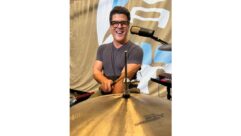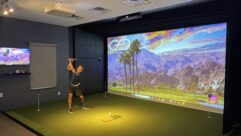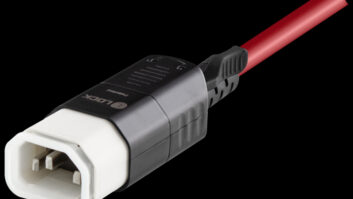AN EYE FOR DETAIL
Jul 1, 1998 12:00 PM,
Andrew T. Martin
Loudspeaker array theory can be a controversial subject due to the variedopinions regarding the importance of acoustic wavefront alignment, acousticcenter alignment, apparent center alignment, cavity resonance effects,point source design implications and other physical and electro-acousticfactors. This article does not intend to argue the significance of any oneapproach; however, various statements of fact will be made whereappropriate. This article does intend to present a multitude of loudspeakerrigging methodologies that are commonly found in the professional audioindustry.
Before examining various loudspeaker rigging system approaches, it is vitalthat the readers understand that all suspension systems must be rated foroverhead suspension and must comply with all applicable safety codes foroverhead suspension devices. For this reason, some regularly encounterednon-compliant rigging systems will not be presented in this article.Additionally, see Figure 1 for an explanation of the terminology to be usedin this article.
Function, speed, safety and costThere are many compromises designed into loudspeaker rigging systems. Amongthe most often compromised are cost vs. flexibility, cost vs. safety andspeed vs. flexibility.
It is an inherent truth that more complex mechanical devices cost more toproduce and therefore require a higher investment to own. Loudspeakerrigging systems that are high in function also command a higher investment.The cost vs. flexibility compromise is commonly used as a successful designtactic to reduce the total investment in the rigging system by eliminatingunnecessary features. There is no reason to purchase a system with allfeatures imaginable if a simple beam to suspend and tilt an individualloudspeaker will suffice.
On the other hand, although it seems foolish to trade the safety of anoverhead suspension system for a lower price, many professionals simply donot realize they are participating in this dangerous practice. Thecircumstances surrounding the installation and use of an unsafe riggingsystem often consist of an unfamiliar professional attempting to suspend acluster to the best of his ability. Unfortunately, even the best intentionscan lead to the construction of a dangerous system. I am intimatelyfamiliar with phrases and justifications from professionals within theindustry that are meant to divert the responsibility for installing aquestionable rigging system, including “We just over-build the riggingsystem,” and, “We’ve always done it like that, and we’ve never had anaccident.” Both are clear indicators that the rigging system may beinappropriate for the application and/or unsafe to use. The cost vs. safetycompromise has no place in the industry, nor do governmental agenciesacknowledge the argument. Safety must always be held paramount to all otherconcerns.
Speed and flexibility are not often complimentary features of loudspeakerrigging systems, although there are a few systems that accommodate bothperformance factors well. One popular tactic is to use a speed-sensitiverigging system for touring or portable applications, while investing a bitmore time in setting up permanent installations or smaller loudspeakerclusters. There is a break-even point with this tactic; at a certain point,the expense of the time used to set up the rigging system will exceed theadditional investment of purchasing a faster rigging system, andvice-versa. As a result, installations can often encounter cost savings byinvesting in a fast rigging system and saving large amounts on installationlabor and other installation expenses.
Loudspeaker alignmentGenerally speaking, most electro-acoustic engineers agree that loudspeakersplaced properly within a cluster increase sound system intelligibility, aresult of the interaction among sound sources within the loudspeakercluster. Assuming that the loudspeaker is designed well (and taking someliberties for ease of explanation) one can consider the loudspeaker asingle energy source within the loudspeaker array. The interaction ofenergy sources generates various detrimental effects if the energy is notbeing emitted from each sound source at precisely the same place in spaceat the same point in time. These effects manifest themselves ascomb-filtering and lobing. Comb-filtering consists of very narrow bandpeaks and dips in acoustic energy, which can easily exceed 30 dB. The neteffect of comb filtering is a loss of intelligibility that cannot beequalized or processed back into the system electronically. Lobing effectsare similar, but energy lobes can be broader in bandwidth and will emitfrom the loudspeaker cluster in indeterminate directions. Theseuncontrolled emissions produce unwanted room reflections and increaseambient noise energy in the environment, thereby reducing intelligibility.Again, lobing effects cannot be equalized or electronically processed outof the loudspeaker system.
There are two ways of dealing with the effects of comb-filtering andlobing. First, the loudspeaker array can be designed and suspended as apoint-source array. Second, the loudspeaker array can be intentionallyskewed so far off placement that the effects are minimized.
Point-source array technology is the more common of the two practices.Point source simply means grouping together the loudspeakers such that theenergy emitted from each loudspeaker originates at the same theoreticalpoint in space. This is difficult to achieve because the loudspeakerenclosure does not behave as a single energy source. The averageloudspeaker has multiple acoustic drivers working together to cover thedesired range of frequencies; therefore, it is hard to know where to alignthe loudspeakers in space because the acoustic centers of thehigh-frequency, mid-frequency and low-frequency drivers within theloudspeaker are located at different points in space. The question thenbecomes, where do the most noticeable effects occur, because this would bethe most likely place to concentrate efforts to array the loudspeakers mostappropriately. It is generally agreed that the mid-range andintelligibility ranges of frequencies are the best place to generate apoint-source loudspeaker cluster. This means that loudspeaker placementwithin the array must be controlled to within approximately 1/4 inch (6mm). Most acoustically considerate loudspeaker rigging systems approachthis task by aligning the acoustic wavefronts of the loudspeakers. This isnot the best location for alignment; however, it often seems to be the mostpractical way to address a variety of loudspeaker types. By maintainingproper acoustic wavefront alignment, the loudspeaker suspension hardwareincreases the intelligibility of the sound system.
Intentionally skewing the sound sources can also be effective, althoughthis technique is generally used only within permanent installationsbecause it requires significant electronic delays and measurements toimplement correctly. The idea is to place the sound sources so far apartfrom one another that their energy arrival times to the listener are notperceived as the same source. Then, the sound sources are delayed back tothe same point in space. This process is time consuming because manymeasurements must be taken throughout the environment to be sure the soundsources are not generating lobing or comb-filtering effects off-axis, whichwould be caused by most directive horn flares and wave guides. Most riggingsystems of this type are customized structures with an architectural lookpredominantly used for permanent installations.
Common rigging systemsSeveral rigging systems are available from overhead suspension hardwaremanufacturers. These systems not only save time and effort for theprofessional, but they also offer product liability protection notavailable if an individual designs and builds his own rigging hardware.Product liability consequences are a major concern for any industryprofessional because one accident can mean litigation. The simplest way tominimize product liability exposure is to purchase exclusively hardwareintended for overhead suspension from manufacturers that include producttraceability controls on their offerings, and then use the productsaccording to instructions.
Horizontally configured arrays (see Figure 2) are designed to hold eachloudspeaker enclosure together primarily in the horizontal plane, with thevertical plane secondary. The horizontally configured array enables compactand low-profile loudspeaker clusters to be constructed. The acousticcharacteristics of this rigging system are excellent because the acousticwavefront alignment (zenith) of each loudspeaker can be maintained veryclosely, while allowing various splay angles between loudspeakers.Additionally, it is possible to align the acoustic wavefront in thevertical plane as well as the horizontal plane, thereby building apseudo-point-source array. Splay angles and tilt angles can also bemaintained with close tolerance and repeatability. Disadvantages of thisrigging approach include a higher investment because of system flexibility,a moderate time investment for larger array constructions and potentialchallenges with energy spill into the venue side areas from severelydown-tilted loudspeakers and the changing rotation of the loudspeakerswithin the row.
Vertically configured arrays(see Figure 3), also called columnar arrays,are designed to hold the loudspeakers primarily in a vertical orientation,with the horizontal plane secondary. This approach to suspendingloudspeaker clusters can be very fast to assemble and disassemble; it canalso easily focus energy to many zones within a venue. However, thevertically configured array is not practical when building a point-sourcearray because of the need to gap the columns apart from one another inorder to allow splay angles between columns. Additionally, it is verydifficult to maintain a coherent zenith alignment in the vertical plane asthe loudspeakers are tilted down. It is possible, however, to retain somevertical alignment for two to three rows of loudspeakers withoutintroducing a tremendous tensional load on the loudspeakers and suspensionsystem.
Point-source arrays (see Figure 4) are a combination of the horizontal andvertical configuration, while incorporating trade-offs from bothapproaches. When designed with a clear understanding of where the systemneeds to acoustically perform best, the point-source array can beimpressive. These arrays are usually custom built for a specificinstallation and can be quickly assembled, depending upon the design.Because they are custom designed, the splay, tilt, rotation and zenith canall be appropriately planned.
Line arrays (see Figure 5) are a refined form of a vertically configuredarray. The line array maintains close tolerance in the vertical plane totake advantage of close-coupling effects to steer array dispersion andincrease acoustic output. Line arrays are not usually used in multiplecolumns and therefore do not realize the effects of horizontal acousticalconflicts.
Rigging hardwareRegardless of the type of loudspeaker array, the system will be only asstrong as its weakest link. The importance of safety and conservativedesign methods cannot be stressed enough when considering the weight of theaverage loudspeaker array and the overhead suspension placement in mostapplications. There is simply no room for error or guesswork. The weak linkin an array may be the wire rope sling suspending the grid or perhaps theshackle or turnbuckle connecting to an eyebolt. It can also be theloudspeaker enclosure itself or the fitting used to attach to theloudspeaker hardware. The loudspeaker array must be designed to maintainappropriate design factors throughout the rigging system.
Attachment to the structure can be one of the more complicated aspects ofrigging loudspeaker arrays because of the variety of installation methodsand the multitude of structure construction types. A professional engineercan help a great deal in determining the best method of attachment to thestructure. Additionally, a professional engineer can decide if the buildingis strong enough to support the concentrated load that most loudspeakerarrays will generate on the structure. In some states and/ormunicipalities, there are structural guidelines that must be followed whenrigging a loudspeaker array, and a professional engineer can help withthese issues as well as afford liability protection.
Final thoughtsLoudspeaker arrays are constructed in countless variations of styles andapproaches, but they all have one thing in common-they are heavy objectssuspended above the heads of the public. The priority of the loudspeakerarray designer and installer must be placed on the safety of the suspensionsystem and the proper installation of the array. Acoustic characteristicscan be accounted for, and proper placement of the loudspeakers can beworked into the array to produce a very coherent loudspeaker clusterwithout compromising system safety. It is the responsibility of eachindustry professional to hold himself personally accountable for safeloudspeaker arrays.










